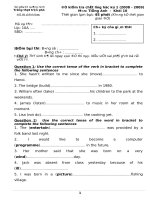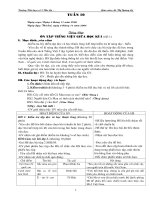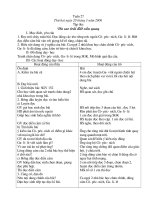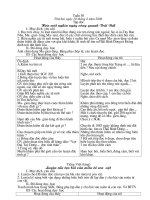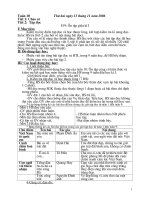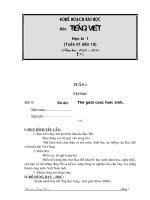tieng anh 5 tuan 10
Bạn đang xem bản rút gọn của tài liệu. Xem và tải ngay bản đầy đủ của tài liệu tại đây (135.48 KB, 8 trang )
<span class='text_page_counter'>(1)</span>Date of planning: 26/10/2016. Week: 10. Date of teaching: 31/10-04/11/2016. Period 37 th. UNIT 6: HOW MANY LESSONS DO YOU HAVE TODAY? Lesson 1: Part 4-5-6 I. Objectives: 1Knowledge: •. use the words and phrases related to the topic School lessons.. •. ask and answer questions about school lessons, using How many lessons do you have. today? I have ... 2. Skills: - Develop Ps speaking and listening skills 3. Language focus: - Vocabulary and structures: review II. Teaching aids: 1. Teacher’s: student’s and teacher’s book, pictures, cassette. 2. Students’: books, notebooks, workbooks. III. Teaching processes:. Teacher’s activities I. Warm up: Play the game “jumbled letters”. Students’ activities - Play the game. II. New lesson: 4. Listen and tick • Tell the class that they are going to listen to the recording and tick the timetable in their books. • Ask them to read the names and lessons in the. - Listen to the tape - Listen and do the task - Answer the question.. timetable. Then play the recording all the way through for them to listen. Play it again for them to do the task. • Get pupils to compare their answers before checking as a class. Give explanations for answers which pupils find difficult. Play the recording again to confirm the answers. Key: Long: Maths, IT and Science. - Listen to the teacher.
<span class='text_page_counter'>(2)</span> - Do as directed.. Minh: Science, Music, Art and IT Lan: Vietnamese, English, Maths, IT and PE. - Individually - Work in pairs. 5. Read and complete • Tell the class that they are going to read the text and fill the gaps with Art, four, lessons, Wednesday and Tuesday. Give them a few seconds to read. Remind them to focus on the context to select the appropriate words from the. - The whole class read aloud. box. • Set a time limit for them to do the task independently.. - Listen to the teacher. • Get pupils to compare their answers in pairs before checking as a class. • Key:. 1 Tuesday. - Read each line of the 2 lessons. 3 Wednesday 4. four. 5 Art. lyrics - Listen to the tape. 6Let’s sing. - Listen and repeat each. • - Tell the class that they are going to sing How many. line. lessons do you have today? Have them read the lyrics. - The whole class. and. - Practice in groups. teach. the. unfamiliar. words.. Check. their. comprehension.. - The whole class. • Play the recording all the way through for them to listen and follow in their books. Play it again for them to repeat line by line. When pupils are familiar. - Retell. with the melody, ask them to sing along with the music before having them practise doing actions. • Invite a group to sing the song and do actions in front of the class. • III. Consolidation - Retell the content of the lesson. IV. Homework - Do exercises in the workbook. Prepare the next period.. - Remember.
<span class='text_page_counter'>(3)</span> Date of planning: 26/10/2016. Week: 10. Date of teaching: 31/10-04/11/2016. Period 38 th. UNIT 6: HOW MANY LESSONS DO YOU HAVE TODAY? Lesson 2: Part 1-2-3 I. Objectives: 1. Knowledge: • use the words and phrases related to the topic School lessons. • ask and answer questions about how often someone has a subject, using How often do you have ...? I have it + frequency expression. 2. Skills: - Develop Ps speaking and listening skills. 3. Language focus: - Vocabulary: break, once, twice… • - Structures: How often do you have ...? I have it + frequency expression. II. Teaching aids: 1. Teacher’s: student’s and teacher’s book, pictures, cassette. 2. Students’: books, notebooks, workbooks. III. Teaching processes: Teacher’s activities I. Warm up: Spend a few minutes having the class. Students’ activities - Sing the song. sing How many lessons do you have today? Then ask them to spell these words: Akiko, Nam, school, class, have, lessons, today, week, once, twice and times. Have pupils make sentences with the words. II. New lesson: 1. Look, listen and repeat • Tell the class that they are going to read a story. Check comprehension by pointing at each picture to elicit their answers to these questions: What’s his/her name? Who is he/she talking with? What are they talking about. - Listen - Look at the pictures and answer: • In Picture a, Akiko is talking to Nam on the Internet. • In Picture b, Nam says he’s at school and it’s break time. • In Picture c, Akiko says.
<span class='text_page_counter'>(4)</span> she’s. • Play the recording all the way through for. at. home. and. pupils to listen and follow in their books.. studying for her English. Play it again for them to repeat the lines. lesson.. in the bubbles. Finally, point to each. • In Picture d, Nam asks How often do you have. picture for the class to say the words in. English?. each bubble. 2. Point and say •-. Tell the class that they are going to. practise asking and answering questions about how many times they have a lesson in a week, using How often do you have ...? I have it ... •Have them practise the questions, using a substitution drill. Point at each picture for them to say the question. Explain the words. and. Akiko. answers I have it four times a week. - Listen - Listen and repeat - Do as directed - Listen - Listen and copy + Listen and repeat + Groups, individuals - Listen and copy. under each picture and have pupils repeat them once or twice before practising the answers. Finally, point to each picture and. - Do as directed - Listen. say the question for the class to answer. • Ask pupils to work in pairs. Monitor the activity. - Work in pairs. and offer help, if necessary. • Invite one or two pairs to perform the activity. 3Let’s talk: •-. - Some pairs perform in front of class. Tell the class that they are going to. practise further by asking and answering the. - Listen to the teacher. questions in their books. If you want to add variety, you can invite them to imagine they are in different schools and give different answers. Tell them to make their own timetables before practising.. - Remember.
<span class='text_page_counter'>(5)</span> • Set a time limit for pupils to practise. Monitor the activity and offer help, if necessary. • Invite two or three pairs to act out their conversations. Then give feedback. III. Consolidation: - Summary the lesson IV. Homework: - Do exercises in workbook, learn by heart the new words Date of planning: 26/10/2016. Week: 10. Date of teaching: 31/10-04/11/2016. Period 39 th. UNIT 6: HOW MANY LESSONS DO YOU HAVE TODAY? Lesson 2: Part 4-5-6 I. Objectives: 1. Knowledge: • use the words and phrases related to the topic School lessons. • ask and answer questions about how often someone has a subject, using How often do you have ...? I have it + frequency expression. 2. Skills: - Develop Ss reading, writing and listening skills 3. Language focus: - Vocabulary: Review II. Teaching aids: 1. Teacher’s: student’s and teacher’s book, pictures, cassette. 2. Students’: books, notebooks, workbooks. III. Teaching processes:. Teacher’s activities I. Warm up: Play the game: Order the words. Students’ activities - Play game. II. New lesson: 4. Listen and circle a or b. • Tell the class that they are going to listen and circle a or b to complete the sentences.. Ask them to read. - Listen to the teacher.
<span class='text_page_counter'>(6)</span> - Listen to the tape. the sentences and guess the answers. • Play the recording all the way through for pupils to. - Listen and do the task. listen. Play it again for them to do the task. • Get pupils to compare their answers before checking as a class. Key:. 1a. 2a. 3b. 4a. 5. Write about you. - Listen. • Tell the class that they are going to write about their. - Do the task. lessons. Have pupils read the questions and check their. - Individually. understanding.. - Work in pairs. • Set a time limit for them to do the writing independently. Monitor the activity and offer help, if necessary.. - Some Ps - The whole class. • Get pupils to swap and read their writing before inviting two or three pupils to read their answers aloud. • Key:. Answers vary. 6Let’s play: ••. Tell the class that they are going to play Slap. the board. Practise the names of the subjects and. - Listen. the frequency expressions with them first. Display the pictures on the board as in the Student’s Book.. - Do as directed. Then ask two groups of four pupils to stand at the board.. Call. out. the. subjects. or. frequency. - Listen. expressions for the groups to slap. The slower group is out and the quicker group will play against. - Play in groups. a new group. The team that stays in the game until the end is the winner. • Have the class make sentences with the names of the subjects and the frequency expressions. III. Consolidation - Summary the lesson. - Listen - Remember.
<span class='text_page_counter'>(7)</span> IV. Homework - Do exercises in workbook, prepare the next period. Date of planning: 26/10/2016. Week: 10. Date of teaching: 31/10-04/11/2016. Period 40 th. UNIT 6: HOW MANY LESSONS DO YOU HAVE TODAY? Lesson 3: Part 1-2-3 I. Objectives: 1Knowledge: By the end of this lesson. Pupils can: • say questions and answers with the correct sentence stress. 2. Skills: - Develop Ps writing and listening skills 3. Language focus: - Vocabulary and structures: Review • - Phonics: stress on questions and answers II. Teaching aids: 1. Teacher’s: student’s and teacher’s book, pictures, cassette. 2. Students’: books, notebooks, workbooks. III. Teaching processes:. Teacher’s activities I. Warm up: Play game: Pass the secret!. Students’ activities - Play the game. II. New lesson: 1. Listen and repeat • Tell the class that they are going to practise saying. - Listen to the teacher. questions and answers with the correct sentence. - Listen to the tape. stress.. - Listen and repeat in choral,. • Play the recording all the way through for pupils to. groups and individual. listen and follow in their books. Then play it again for them to repeat the sentences twice. 2. Listen and circle. Then say aloud • Tell the class that they are going to listen and circle a or b to complete the sentences. • Give them a few seconds to read the sentences in silence. - Listen to the teacher - Look at the books and guess.
<span class='text_page_counter'>(8)</span> before playing the recording twice for them to do the. - Listen and write. task. • Get them to compare their answers in pairs before checking as a class.. - Listen and check - Read aloud. Key: 1 a, b 2 b, a - Listen to the teacher 3. Let’s chant • Tell the class that they are going to say the chant. - Read the chant. How often do you have ...? Have them read the chant. - Do as directed. and check their comprehension.. - Practice in groups. • Play the recording all the way through for pupils to listen and follow in their books. Play it again for them. - Work in pairs. to repeat each line. • Put the class into two groups to practise chanting the. - The whole class. questions and answers respectively. • Have them practise saying the chants and doing actions in groups.. - Listen. • Invite two or three groups to say the chant and do actions. III. Consolidation - Summary the lesson IV. Homework - Do exercises in workbook, prepare the next period.. - Remember.
<span class='text_page_counter'>(9)</span>

